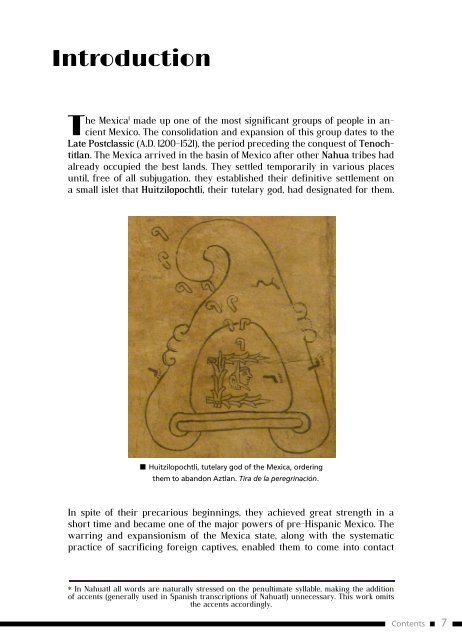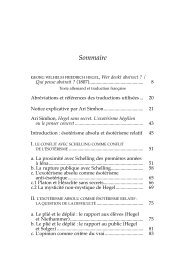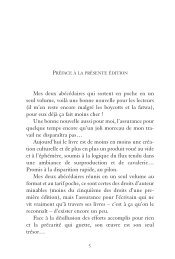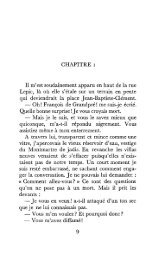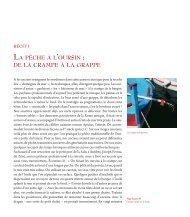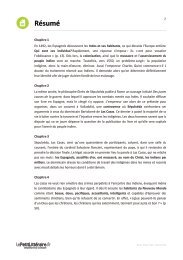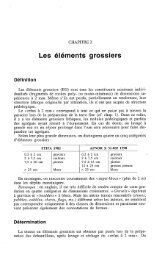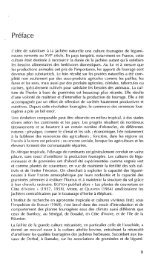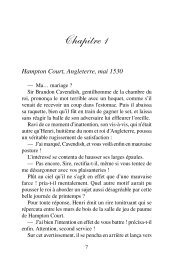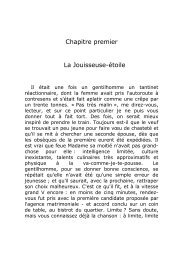Outsiders and Outcasts in the Mexica World - Numilog
Outsiders and Outcasts in the Mexica World - Numilog
Outsiders and Outcasts in the Mexica World - Numilog
Create successful ePaper yourself
Turn your PDF publications into a flip-book with our unique Google optimized e-Paper software.
Introduction<br />
The <strong>Mexica</strong> 1 made up one of <strong>the</strong> most significant groups of people <strong>in</strong> ancient<br />
Mexico. The consolidation <strong>and</strong> expansion of this group dates to <strong>the</strong><br />
Late Postclassic (A.D. 1200–1521), <strong>the</strong> period preced<strong>in</strong>g <strong>the</strong> conquest of Tenochtitlan.<br />
The <strong>Mexica</strong> arrived <strong>in</strong> <strong>the</strong> bas<strong>in</strong> of Mexico after o<strong>the</strong>r Nahua tribes had<br />
already occupied <strong>the</strong> best l<strong>and</strong>s. They settled temporarily <strong>in</strong> various places<br />
until, free of all subjugation, <strong>the</strong>y established <strong>the</strong>ir def<strong>in</strong>itive settlement on<br />
a small islet that Huitzilopochtli, <strong>the</strong>ir tutelary god, had designated for <strong>the</strong>m.<br />
Huitzilopochtli, tutelary god of <strong>the</strong> <strong>Mexica</strong>, order<strong>in</strong>g<br />
<strong>the</strong>m to ab<strong>and</strong>on Aztlan. Tira de la peregr<strong>in</strong>ación.<br />
In spite of <strong>the</strong>ir precarious beg<strong>in</strong>n<strong>in</strong>gs, <strong>the</strong>y achieved great strength <strong>in</strong> a<br />
short time <strong>and</strong> became one of <strong>the</strong> major powers of pre-Hispanic Mexico. The<br />
warr<strong>in</strong>g <strong>and</strong> expansionism of <strong>the</strong> <strong>Mexica</strong> state, along with <strong>the</strong> systematic<br />
practice of sacrific<strong>in</strong>g foreign captives, enabled <strong>the</strong>m to come <strong>in</strong>to contact<br />
* In Nahuatl all words are naturally stressed on <strong>the</strong> penultimate syllable, mak<strong>in</strong>g <strong>the</strong> addition<br />
of accents (generally used <strong>in</strong> Span ish transcriptions of Nahuatl) unnecessary. This work omits<br />
<strong>the</strong> accents accord<strong>in</strong>gly.<br />
Contents 7
with a great variety of people hav<strong>in</strong>g different languages <strong>and</strong> customs, on<br />
whom <strong>the</strong>y imposed tribute. War <strong>and</strong> tributary subjection were among <strong>the</strong><br />
catalysts for <strong>in</strong>terethnic relations among Nahua groups 2 —those who lived <strong>in</strong><br />
<strong>the</strong> bas<strong>in</strong>—<strong>and</strong> foreign-speak<strong>in</strong>g people.<br />
Expansion of <strong>the</strong> <strong>Mexica</strong> Empire (based on López Aust<strong>in</strong> <strong>and</strong> López Luján).<br />
MEXICO<br />
Tuxpan<br />
MEXICO<br />
METZTITLÁN<br />
Texcoco<br />
Tlacopan<br />
Tz<strong>in</strong>tzuntzán<br />
MICHOACÁN<br />
Tenochtitlan<br />
TLAXCALA<br />
Tlaxcala<br />
TEOTITLÁN<br />
DEL CAMINO<br />
Gulf of Mexico<br />
YOPITZINCO<br />
MIXTEC<br />
LORDLY<br />
DOMAINS<br />
COATLICÁMAC<br />
Oaxaca<br />
Pacific Ocean<br />
TUTUTEPEC<br />
SOCONUSCO<br />
<strong>Mexica</strong> Empire<br />
Triple Alliance<br />
Independent political units<br />
Road to Soconusco<br />
But <strong>the</strong>se peripheral cultures presented a great many customs that were not<br />
<strong>in</strong> keep<strong>in</strong>g with <strong>Mexica</strong> practices: those concern<strong>in</strong>g food, bodily treatment,<br />
styles of dress <strong>and</strong> adornment, <strong>and</strong> <strong>the</strong> characteristics of sacrifices, among<br />
o<strong>the</strong>r features. The fact that foreigners spoke a language o<strong>the</strong>r than Nahuatl<br />
was one of <strong>the</strong> essential criteria that formed <strong>the</strong>ir alterity. We need only read<br />
Introduction<br />
Contents<br />
8
ook 10, chapter 29, of <strong>the</strong> Florent<strong>in</strong>e Codex—compiled by <strong>the</strong> Franciscan friar<br />
Bernard<strong>in</strong>o de Sahagún <strong>in</strong> <strong>the</strong> second half of <strong>the</strong> sixteenth century, with <strong>the</strong><br />
collaboration of Nahua <strong>in</strong>formants—to see what <strong>the</strong> <strong>Mexica</strong>, <strong>and</strong> <strong>the</strong> Nahuas<br />
<strong>in</strong> general, thought of <strong>the</strong>ir foreign neighbors, both near <strong>and</strong> far. This text<br />
exposes <strong>the</strong>ir Nahuacentric view of different ethnic groups, for it does not<br />
stop at describ<strong>in</strong>g <strong>the</strong> physical characteristics <strong>and</strong> cultural ways of <strong>the</strong>se<br />
people but also criticizes <strong>the</strong>m, measur<strong>in</strong>g <strong>the</strong>m aga<strong>in</strong>st <strong>the</strong> <strong>Mexica</strong>’s own<br />
ideals. This can be seen very clearly <strong>and</strong> schematically <strong>in</strong> references to <strong>the</strong><br />
Otomi <strong>and</strong> <strong>the</strong> Cuextecs. 3 While po<strong>in</strong>t<strong>in</strong>g out <strong>the</strong>ir supposed faults, <strong>in</strong>stead of<br />
giv<strong>in</strong>g an objective description of those aspects, <strong>the</strong> text exalts <strong>the</strong> <strong>Mexica</strong><br />
moral system. Everyth<strong>in</strong>g that does not agree with that system becomes a<br />
transgression. Thus, <strong>the</strong> foreigner was made out to be an immoral be<strong>in</strong>g,<br />
moreover characterized by dullness <strong>and</strong> <strong>in</strong>eptitude. 4 At <strong>the</strong> same time, <strong>the</strong><br />
way <strong>in</strong> which <strong>the</strong> <strong>Mexica</strong> spoke of non-Nahua foreigners reflected <strong>the</strong> wars<br />
<strong>the</strong>y waged aga<strong>in</strong>st <strong>the</strong>m, s<strong>in</strong>ce all were considered enemies of <strong>the</strong> Empire<br />
for cont<strong>in</strong>ually counter<strong>in</strong>g <strong>the</strong>ir military attacks <strong>and</strong> resist<strong>in</strong>g <strong>the</strong>ir tribute.<br />
Foreigners were <strong>in</strong>corporated not only <strong>in</strong> <strong>the</strong> moral system but also <strong>in</strong> rituals,<br />
myths, <strong>and</strong> war; <strong>the</strong>y played important religious <strong>and</strong> social roles.<br />
Human sacrifice through heart extraction.<br />
Florent<strong>in</strong>e Codex.<br />
Introduction<br />
Contents 9
The Otomi were portrayed with long hair <strong>and</strong> cloaks made of wild animal sk<strong>in</strong>s.<br />
Florent<strong>in</strong>e Codex.<br />
But <strong>the</strong> <strong>Mexica</strong> also recognized <strong>and</strong> repudiated those <strong>in</strong> <strong>the</strong>ir own community<br />
who did not completely satisfy <strong>the</strong>ir social <strong>and</strong> moral requirements, such as<br />
youths who failed to respect parental orders, or heavy dr<strong>in</strong>kers, vagabonds,<br />
lunatics, <strong>and</strong> women of loose or “happy” ways.<br />
Foreigners <strong>and</strong> socially marg<strong>in</strong>alized figures shared many traits of immorality;<br />
<strong>in</strong>deed, <strong>the</strong>ir identities could be merged <strong>in</strong>to one: <strong>the</strong> Cuextec man<br />
resembled <strong>the</strong> drunkard <strong>and</strong> <strong>the</strong> lunatic; <strong>the</strong> Otomi woman <strong>and</strong> man, <strong>the</strong><br />
prostitute <strong>and</strong> vagabond, respectively. They constituted <strong>the</strong> <strong>Mexica</strong> counterideal,<br />
a common element <strong>in</strong> <strong>the</strong> general process of self-def<strong>in</strong>ition through<br />
negative identification—that is, through what one is not.<br />
Introduction<br />
Prostitute hold<strong>in</strong>g flowers <strong>and</strong> shown with<br />
sea motifs. Florent<strong>in</strong>e Codex.<br />
Contents 10
<strong>Mexica</strong> Moral<br />
<strong>and</strong> Behavioral Systems<br />
<strong>Mexica</strong> moral ideals can be summed up by <strong>the</strong> adage tlacoqualli <strong>in</strong><br />
monequi, “<strong>the</strong> good medium is necessary,” 5 exhort<strong>in</strong>g moderation<br />
<strong>in</strong> one’s dress, bear<strong>in</strong>g, speech, eat<strong>in</strong>g, <strong>and</strong> sexual behavior. This pr<strong>in</strong>ciple was<br />
expressed through a series of admonitory speeches called hue huetlatolli, or<br />
“ancient word.” Such speeches were an everyday part of family life, among<br />
not only nobles but also artisans <strong>and</strong> macehuales. They <strong>in</strong>cluded courtesy<br />
formulas along with advice, exhortations, <strong>and</strong> warn<strong>in</strong>gs that parents would<br />
give to <strong>the</strong>ir children. 6<br />
There were surely differences among<br />
<strong>the</strong> huehuetlatolli for different classes,<br />
<strong>and</strong> not merely <strong>in</strong> terms of rhetoric.<br />
For example, although moderation was<br />
urged at every social level, <strong>the</strong> rul<strong>in</strong>g<br />
<strong>Mexica</strong> goddess <strong>in</strong> <strong>the</strong> typical female<br />
posture: rest<strong>in</strong>g on her knees.<br />
FCAS collection. INAH 1041-210.<br />
<strong>Mexica</strong> man <strong>in</strong> <strong>the</strong> typical male<br />
posture: st<strong>and</strong><strong>in</strong>g.<br />
Museo Nacional de Antropología.<br />
Contents 11
A ruler exhorts his people. Florent<strong>in</strong>e Codex.<br />
class enforced <strong>the</strong> most str<strong>in</strong>gent limits on<br />
behavior <strong>in</strong> order to justify <strong>the</strong>ir superior<br />
status before <strong>the</strong> macehual masses. In<br />
this way <strong>the</strong> noble dist<strong>in</strong>guished himself<br />
from <strong>the</strong> peasant, while, on ano<strong>the</strong>r level,<br />
this behavioral code dist<strong>in</strong>guished <strong>the</strong><br />
<strong>Mexica</strong> ethnic group from all o<strong>the</strong>rs <strong>and</strong><br />
positioned <strong>the</strong> foreigner at <strong>the</strong> opposite<br />
extreme <strong>in</strong> terms of correct behavior.<br />
A fa<strong>the</strong>r exhorts his son to good<br />
behavior. Florent<strong>in</strong>e Codex.<br />
The Proper Way to Walk<br />
A fa<strong>the</strong>r <strong>in</strong>structs his son:<br />
You must be prudent <strong>in</strong> your travels;<br />
peacefully, calmly, tranquilly […] are you<br />
to go, to take to <strong>the</strong> road, to travel. Do not<br />
throw your feet much, nor raise <strong>the</strong>m<br />
high, nor go jump<strong>in</strong>g, lest you be called<br />
foolish, shameless. Nor are you to go very<br />
slowly, or drag your feet. 7 […] nei<strong>the</strong>r too<br />
hurriedly nor too leisurely, but with honesty<br />
<strong>and</strong> maturity [are you to go]. 8<br />
O<strong>the</strong>rwise, as Sahagún <strong>in</strong>dicates, one<br />
would be called ixtotomac cuecuetz.<br />
The young noblewoman was told to walk<br />
without haste, that is, without restlessness<br />
(cuecuetzyotl), 9 <strong>and</strong> without w<strong>and</strong>er<strong>in</strong>g,<br />
so as not to seem ostentatious;<br />
she was to keep her head lowered as<br />
she walked, show<strong>in</strong>g no pride; <strong>and</strong> she<br />
was not supposed to look up or from<br />
side to side, s<strong>in</strong>ce that would <strong>in</strong>dicate<br />
<strong>Mexica</strong> Moral <strong>and</strong> Behavioral Systems<br />
Contents 12
hypocrisy. Nor should she behave<br />
sheepishly or cover her mouth, <strong>and</strong><br />
by no means could she look someone<br />
directly <strong>in</strong> <strong>the</strong> eye. 10 She was to walk<br />
nei<strong>the</strong>r hurriedly nor slowly, nei<strong>the</strong>r<br />
lift<strong>in</strong>g her feet high nor dragg<strong>in</strong>g <strong>the</strong>m;<br />
mov<strong>in</strong>g <strong>in</strong> a straight l<strong>in</strong>e, with no sway<strong>in</strong>g<br />
motion.<br />
Noblewoman. Florent<strong>in</strong>e Codex.<br />
Cloth<strong>in</strong>g <strong>and</strong> Personal Groom<strong>in</strong>g<br />
The type of cloth<strong>in</strong>g a person wore constituted<br />
a language that communicated<br />
his or her status: social class, ethnicity,<br />
<strong>and</strong> age; it also <strong>in</strong>dicated how to<br />
act <strong>and</strong> what attitude to take toward a<br />
particular <strong>in</strong>dividual. It is possible that<br />
<strong>the</strong> Nahuas related certa<strong>in</strong> attire <strong>and</strong><br />
adornments with specific behaviors,<br />
s<strong>in</strong>ce moderation <strong>in</strong> dress prevailed<br />
over excess <strong>and</strong> ostentation. Nei<strong>the</strong>r<br />
men nor woman were to wear gaudy<br />
clo<strong>the</strong>s (topallotl), garments covered<br />
<strong>in</strong> adornment, because do<strong>in</strong>g so would<br />
imply vanity, “little sense <strong>and</strong> folly”;<br />
but nor were <strong>the</strong>y to dress <strong>in</strong> tatters<br />
(tzotzomatli), “a sign of poverty <strong>and</strong><br />
baseness” for nobles <strong>and</strong> of ridicule for<br />
<strong>the</strong> rest of society. 11<br />
There were quite precise <strong>in</strong>structions<br />
on how to wear a cape or cloak correctly.<br />
A young pilli was forbidden to<br />
let it drag on <strong>the</strong> ground or to wear it<br />
hang<strong>in</strong>g so far down that he would trip<br />
on it while walk<strong>in</strong>g. Nor was he to knot<br />
it so short that it would sit very high, or<br />
<strong>Mexica</strong> Moral <strong>and</strong> Behavioral Systems<br />
Contents 13
Noblewomen display<strong>in</strong>g different hairstyles, based on <strong>the</strong>ir social status. Florent<strong>in</strong>e Codex.<br />
<strong>Mexica</strong> Moral <strong>and</strong> Behavioral Systems<br />
Contents 14
to tie it at <strong>the</strong> armpits. Instead, it was to<br />
be tied <strong>in</strong> such a way that <strong>the</strong> shoulders<br />
would be kept covered. 12<br />
Young men were also persuaded to<br />
shun adornment:<br />
Do not comb your hair constantly; don’t<br />
keep look<strong>in</strong>g at yourself <strong>in</strong> <strong>the</strong> mirror;<br />
don’t cont<strong>in</strong>ually adorn yourself; don’t<br />
groom yourself all <strong>the</strong> time; do not frequently<br />
desire ornament, because it is<br />
noth<strong>in</strong>g more than <strong>the</strong> devil’s way to trap<br />
people. 13<br />
An old man with his cape knotted at armpit level. Codex Mendoza.<br />
<strong>Mexica</strong> Moral <strong>and</strong> Behavioral Systems<br />
Contents 15


